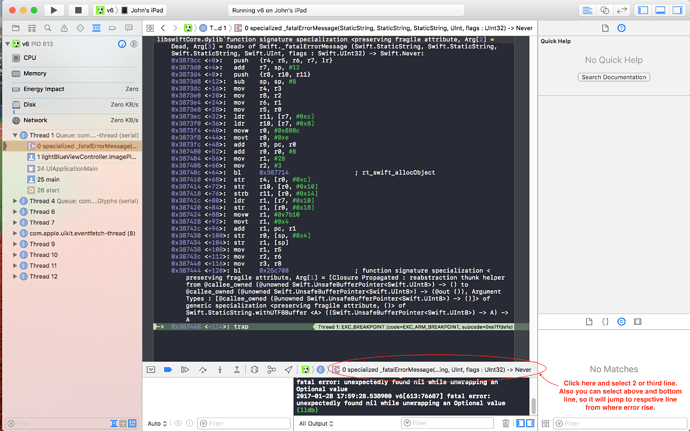I am trying to make a photo app. Depending on the buttons you press it will choose your photo frame. The app includes the ability for the user to enter a custom message to be included in the picture frame. This works perfectly with one of the possible frame options but with the other 3 it gives the fatal error unwrapping message
This is the code for the user to choose the frame they want for there photo.
import UIKit
class ltwoViewController: UIViewController {
@IBOutlet var textFIELD: UITextField!
@IBOutlet var redBUTTON: UIButton!
@IBOutlet var brownBUTTON: UIButton!
@IBOutlet var blueBUTTON: UIButton!
@IBOutlet var greenBUTTON: UIButton!
@IBOutlet var newbutton: UIButton!
@IBOutlet var timerLABEL: UILabel!
@IBOutlet var score1level: UILabel!
@IBOutlet var soccerBall: UIButton!
var level = 0
var timer: Timer?
var isRunning: Bool {
get {
return timer != nil
}}
var counter = 0.0
override func viewDidLoad() {
super.viewDidLoad()
if isRunning {
return
}
refreshTimer()
}
func refreshTimer() {
if let timer: Timer = timer {
timer.invalidate()
}
timer = Timer.scheduledTimer(timeInterval: 0.1 ,target: self,selector: #selector(updateTimer),userInfo: nil, repeats: true)
}
@IBAction func gBUTTON(_ sender: Any) {
level += 1
blueBUTTON.isHidden = true
}
@IBAction func bBUTTON(_ sender: Any) {
level += 11
greenBUTTON.isHidden = true
}
@IBAction func brownBUTTON(_ sender: Any) {
level += 2
}
@IBAction func redBUTTON(_ sender: Any) {
level += 3
}
func updateTimer() {
if counter < 14.9 && level == 3 {
if let nextc = self.storyboard?.instantiateViewController(withIdentifier: "greenViewController") as? greenViewController {
nextc.labelText = textFIELD.text!
self.present(nextc, animated: true, completion: nil)
timer?.invalidate()
}}
counter += 0.1
if counter < 14.9 && level == 4 {
if let nextc = self.storyboard?.instantiateViewController(withIdentifier: "blueViewController") as? blueViewController {
nextc.labelText = textFIELD.text!
self.present(nextc, animated: true, completion: nil)
}}
if counter < 14.9 && level == 13 {
if let nextc6 = self.storyboard?.instantiateViewController(withIdentifier: "silverViewController") as? silverViewController {
nextc6.labelText2 = textFIELD.text!
self.present(nextc6, animated: true, completion: nil)
timer?.invalidate()
}}
if counter < 14.9 && level == 14 {
if let nextc4 = self.storyboard?.instantiateViewController(withIdentifier: "lightBlueViewController") as? lightBlueViewController {
nextc4.labelText = textFIELD.text!
self.present(nextc4, animated: true, completion: nil)
timer?.invalidate()
}}
else if counter >= 15{
let next = self.storyboard?.instantiateViewController(withIdentifier: "loseViewController") as? loseViewController
self.present(next!, animated: true, completion: nil)
timer?.invalidate()
}}}
This is the code for the view controller that works.
extension CALayer {
func addBorder(edge: UIRectEdge, color: UIColor, thickness: CGFloat) {
let border = CALayer();
switch edge {
case UIRectEdge.top:
border.frame = CGRect(x: 0, y: 0, width: self.frame.width, height: 10)
break
case UIRectEdge.bottom:
border.frame = CGRect(x:0, y:self.frame.height - thickness, width:self.frame.width, height:thickness)
break
case UIRectEdge.left:
border.frame = CGRect(x:0, y:0, width: thickness, height: self.frame.height)
break
case UIRectEdge.right:
border.frame = CGRect(x:self.frame.width - thickness, y: 0, width: thickness, height:self.frame.height)
break
default:
break
}
border.backgroundColor = color.cgColor;
self.addSublayer(border)
}}
import UIKit
class blueViewController: UIViewController, UIImagePickerControllerDelegate, UINavigationControllerDelegate, UITextFieldDelegate {
@IBOutlet var imageDISPLAY: UIImageView!
var screenView: UIImageView!
@IBOutlet var zext: UILabel!
var labelText = String()
override func viewDidLoad() {
super.viewDidLoad()
zext.text = labelText
}
@IBAction func saveThePhoto(_ sender: Any) {
let alert = UIAlertController(title: "Image Saved", message: "Image is in photo gallery", preferredStyle: .alert)
let okay = UIAlertAction(title: "OK", style: .default, handler: nil)
alert.addAction(okay)
present(alert, animated: true, completion: nil)
let photo = UIGraphicsGetImageFromCurrentImageContext()
UIGraphicsEndImageContext()
UIImageWriteToSavedPhotosAlbum(photo!, nil, nil, nil)
}
@IBAction func takeTHePhoto(_ sender: Any) {
if UIImagePickerController.isSourceTypeAvailable(UIImagePickerControllerSourceType.camera){
let imagePicker = UIImagePickerController()
imagePicker.delegate = self
imageDISPLAY.layer.addBorder(edge: [.top], color: UIColor.red, thickness: 12.0)
imageDISPLAY.layer.addBorder(edge: [.bottom], color: UIColor.red, thickness: 180.0)
imageDISPLAY.layer.addBorder(edge: [.left], color: UIColor.red, thickness: 50.0)
imageDISPLAY.layer.addBorder(edge: [.right], color: UIColor.red, thickness: 50.0)
imagePicker.sourceType = UIImagePickerControllerSourceType.camera;
imagePicker.allowsEditing = false
self.present(imagePicker, animated: true, completion: nil)}}
func imagePickerController(_ picker: UIImagePickerController, didFinishPickingImage image: UIImage!, editingInfo: [NSObject: AnyObject]!){
imageDISPLAY.image = image
self.dismiss(animated: true, completion: nil);
screenView = UIImageView()
screenView.frame = CGRect(x:0, y: 0, width: self.view.frame.width, height: self.view.frame.height)
let label = zext
label?.font = UIFont(name: (label?.font.fontName)!, size: 122)
label?.frame = (frame: CGRect(x: 125, y: 700, width: self.view.frame.width, height: 300))
label?.textColor = UIColor.green
label?.alpha = 1.0
self.view.addSubview(screenView)
self.view.addSubview(label!)
UIGraphicsBeginImageContext(self.imageDISPLAY.frame.size)
self.view.drawHierarchy(in: self.view.frame, afterScreenUpdates: true)
}}
This is the code for the other view controller that does not work. The message will be transferred however when it comes to saving the photo in the image view. That is when the error message occurs.
import UIKit
class silverViewController: UIViewController, UIImagePickerControllerDelegate, UINavigationControllerDelegate, UITextFieldDelegate {
@IBOutlet var zext2: UILabel!
var labelText2 = String()
@IBOutlet var IMAGEDISPLAY: UIImageView!
var screenView2: UIImageView!
override func viewDidLoad() {
super.viewDidLoad()
zext2.text = labelText2
}
@IBAction func takePHOTO(_ sender: Any) {
if UIImagePickerController.isSourceTypeAvailable(UIImagePickerControllerSourceType.camera){
let imagePicker = UIImagePickerController()
imagePicker.delegate = self
IMAGEDISPLAY.layer.addBorder(edge: [.top], color: UIColor.red, thickness: 12.0)
IMAGEDISPLAY.layer.addBorder(edge: [.bottom], color: UIColor.red, thickness: 180.0)
IMAGEDISPLAY.layer.addBorder(edge: [.left], color: UIColor.red, thickness: 50.0)
IMAGEDISPLAY.layer.addBorder(edge: [.right], color: UIColor.red, thickness: 50.0)
imagePicker.sourceType = UIImagePickerControllerSourceType.camera;
imagePicker.allowsEditing = false
self.present(imagePicker, animated: true, completion: nil)}}
func imagePickerController(_ picker: UIImagePickerController, didFinishPickingImage image: UIImage!, editingInfo: [NSObject: AnyObject]!){
IMAGEDISPLAY.image = image
self.dismiss(animated: true, completion: nil);
IMAGEDISPLAY = UIImageView()
IMAGEDISPLAY.frame = CGRect(x:0, y: 0, width: self.view.frame.width, height: self.view.frame.height)
let label2 = zext2
label2?.font = UIFont(name: (label2?.font.fontName)!, size: 122)
label2?.frame = (frame: CGRect(x: 125, y: 700, width: self.view.frame.width, height: 300))
label2?.textColor = UIColor.blue
label2?.alpha = 1.0
self.view.addSubview(screenView2)
self.view.addSubview(label2!)
UIGraphicsBeginImageContext(self.IMAGEDISPLAY.frame.size)
self.view.drawHierarchy(in: self.view.frame, afterScreenUpdates: true)
}
@IBAction func savePHOTO(_ sender: Any) {
let alert = UIAlertController(title: "Image Saved", message: "Image is in photo gallery", preferredStyle: .alert)
let okay = UIAlertAction(title: "OK", style: .default, handler: nil)
alert.addAction(okay)
present(alert, animated: true, completion: nil)
let photo = UIGraphicsGetImageFromCurrentImageContext()
UIGraphicsEndImageContext()
UIImageWriteToSavedPhotosAlbum(photo!, nil, nil, nil)
}}

